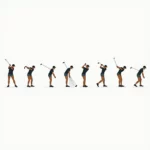When you step onto a golf course, you’re greeted by meticulously manicured fairways, pristine greens, and the notorious rough. For many golfers, the rough is a daunting obstacle that can significantly impact their game. Whether you’re a seasoned pro or just beginning to enjoy this beautiful sport, understanding the rough can vastly improve your performance on the course. In this article, we’ll explore what the rough is, how it affects your game, and tips for conquering this hidden challenge.
What is the Rough?
The rough refers to the area of longer grass that surrounds the fairway and the greens. Unlike the neatly trimmed fairways, the rough can vary significantly in height, thickness, and type of grass, depending on the conditions of the course. It’s designed to create a challenge for players who stray from the fairway.
Types of Rough
- Long Rough: Often found in major tournaments, this type of rough is typically knee-high or taller and can make hitting the ball a real challenge.
- Short Rough: Usually found closer to the fairway, this type is less daunting but can still affect your shot.
- Deep Rough: This can be found along the edges of the course, often filled with weeds and thicker stalks. It’s a real test of a player’s skill.
How the Rough Affects Your Game
The rough changes the way you approach your shots. Here are a few critical aspects to consider:
Club Selection
When you’re in the rough, choosing the right club is crucial. The thick, longer grass can grip the clubhead, reducing the distance the ball travels. Here’s a quick guide:
| Lie Condition | Recommended Club |
|---|---|
| Light Rough | 7-iron or 8-iron |
| Moderate Rough | 5-iron or 6-iron |
| Heavy Rough | 3-iron or hybrid |
Ball Control
When hitting from the rough, you may experience:
- Reduced Spin: The tall grass can inhibit backspin. Shots may roll out more than on the fairway.
- Lack of Trajectory: The grass may also impair the ball’s lift, resulting in lower shots.
Shot Technique
Adapting your swing is essential when battling the rough. Here are some tips for better results:
- Wider Stance: This adds stability and helps combat the loss of balance often caused by uneven lies.
- Steeper Angle of Attack: This is particularly important in the heavy rough, as it helps you get the clubface through the grass and makes contact with the ball.
- Follow-Through: Ensure you finish your swing; this helps improve shot accuracy and distance.
 Golf Course Rough
Golf Course Rough
Tips for Playing from the Rough
Navigating the rough successfully can save your round. Here are some effective strategies:
- Assess the Lie: Determine how thick and high the grass is before selecting your club and planning your shot.
- Use the Right Equipment: Opt for clubs designed for rescue or for performing well in less-than-ideal conditions.
- Focus on Your Grip: Ensure a firm grip on the club to maintain control through the rough.
- Stay Composed: Mental focus is key. Don’t let the rough shake your confidence; remember that many players have faced similar challenges.
Common Mistakes to Avoid
When playing from the rough, even seasoned golfers can fall into traps. Here’s a list of common mistakes to watch out for:
- Using the Same Club as on the Fairway: Always adjust club selection based on the rough’s thickness.
- Lifting the Club Too Much: It might be tempting to swing hard, but a controlled swing is often more effective.
- Losing Focus: Keep your mental game intact; often, a poor shot can lead to frustration.
 Golfer Hitting Ball From Rough
Golfer Hitting Ball From Rough
The Impact of Course Conditions
The condition of the rough is greatly affected by weather, maintenance, and season. Here’s how to adapt:
- Wet Conditions: Grass tends to be heavier and more difficult to navigate. Make sure to account for the extra resistance when choosing your club.
- Dry, Firm Conditions: These can lead to a favorable lie if the grass is thinner—use it to your advantage.
- Seasonal Changes: As seasons change, the rough may grow or thin out, so familiarize yourself with the course during different times of the year.
Practice Makes Perfect
One of the best ways to improve your play from the rough is simply to practice. Here are some drills you can implement:
- Bunker-like Shots: Use the practice area to simulate rough encounters. Angle your clubface and engage in targeted practice.
- Swing Drills: Work on the stability of your follow-through for better shot execution.
- Course Management: Incorporate rough shots into your practice rounds to gain better awareness of different lies.
 Golfer Practicing Rough Shot
Golfer Practicing Rough Shot
Key Takeaways
- The rough is an essential part of golf that adds complexity to the game.
- Assess your lie carefully to select the right club and apply the correct technique.
- Practice is vital; the more time spent in similar scenarios, the better your performance will become.
- Beware of common pitfalls, and maintain a positive mindset to handle tough situations.
FAQ Section
1. What is the primary purpose of the rough in golf?
The rough adds a challenge to the game, penalizing players for straying from the fairway.
2. How can I improve my shots from the rough?
Focus on club selection, adjust your swing technique, and practice regularly.
3. What clubs should I consider when in the rough?
Choose your club according to the thickness of the rough: lighter roughs can accommodate shorter irons, while heavier roughs might require hybrids or 3-irons.
4. Does the type of rough matter?
Absolutely! Longer and thicker grass increases difficulty, while shorter roughs may allow for better shots.
5. Can I practice hitting from the rough?
Yes! Set up drills on your practice range to simulate various rough conditions.
6. What should I do if my ball is buried in the rough?
Play with a steeper angle of attack and consider using a bigger club to help displace the grass.
7. Is it a good idea to practice rough shots on the course?
Absolutely! Incorporating various lies into your practice rounds can improve your overall game.
8. How does weather affect the rough?
Wet weather can thicken the rough, while dry spells may lead to thinner grass, so adapt your strategy accordingly.
9. How important is mental focus when hitting from the rough?
Very! Maintaining composure can help improve shot execution and confidence.
10. Should I always aim to return to the fairway from the rough?
While it’s crucial to get back on track, sometimes an aggressive approach is warranted depending on your situation—always assess your options!
By understanding the rough and incorporating these tips and strategies into your game, you’ll be well-equipped to tackle this challenge head-on. Happy golfing!

